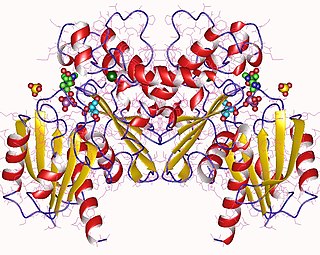| chlorogenate-glucarate O-hydroxycinnamoyltransferase | |||||||||
|---|---|---|---|---|---|---|---|---|---|
| Identifiers | |||||||||
| EC no. | 2.3.1.98 | ||||||||
| CAS no. | 126124-92-3 | ||||||||
| Databases | |||||||||
| IntEnz | IntEnz view | ||||||||
| BRENDA | BRENDA entry | ||||||||
| ExPASy | NiceZyme view | ||||||||
| KEGG | KEGG entry | ||||||||
| MetaCyc | metabolic pathway | ||||||||
| PRIAM | profile | ||||||||
| PDB structures | RCSB PDB PDBe PDBsum | ||||||||
| Gene Ontology | AmiGO / QuickGO | ||||||||
| |||||||||
In enzymology, a chlorogenate-glucarate O-hydroxycinnamoyltransferase (EC 2.3.1.98) is an enzyme that catalyzes the chemical reaction
- chlorogenate + glucarate quinate + 2-O-caffeoylglucarate
Thus, the two substrates of this enzyme are chlorogenate and glucarate, whereas its two products are quinate and 2-O-caffeoylglucarate.
This enzyme belongs to the family of transferases, specifically those acyltransferases transferring groups other than aminoacyl groups. The systematic name of this enzyme class is chlorogenate:glucarate O-(hydroxycinnamoyl)transferase. Other names in common use include chlorogenate:glucarate caffeoyltransferase, chlorogenic acid:glucaric acid O-caffeoyltransferase, and chlorogenate:glucarate caffeoyltransferase.






